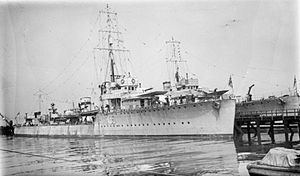Name HMS Valkyrie Laid down 25 May 1916 Launched 13 March 1917 Draft 2.7 m | Ordered July 1916 Commissioned 16 June 1917 Construction started 25 May 1916 Length 91 m | |
 | ||
Builder | ||
HMS Valkyrie was a First World War V-class flotilla leader of the Royal Navy. She was one of two destroyers ordered in July of 1916 from William Denny & Bros. Ltd shipyard under the 9th Order for Destroyers of the Emergency War Program of 1916-17. She was originally to be called HMS Malcolm but was renamed before being completed. The name Malcolm was later assigned to another destroyer leader.
Contents
Construction
In early 1916, the Director of Naval Construction prepared a design for a destroyer leader suitable to lead the new R-class destroyers. The first two ships of the new class, Valkyrie and Valorous were ordered from William Denny and Brothers in April 1916, with three more being ordered from other builders in July that year. Valkyrie's keel was laid on 25 May 1916 at Denny's shipyard in Dumbarton, Scotland. She was launched on 13 March 1917.
Valkyrie was 312 feet (95.10 m) long overall with a beam of 29 feet 6 inches (8.99 m) and a draught of between 10 feet 8 inches (3.25 m) and 11 feet 7 1⁄2 inches (3.54 m) depending on load. She had a displacement of 1,188 long tons (1,207 t) standard and up to 1,473 long tons (1,497 t) under full load.
The ship's machinery was based on that of the R-class destroyers which she was designed to lead. Three oil-fed Yarrow boilers raising steam at 250 pounds per square inch (1,700 kPa) fed Brown-Curtis geared steam turbines which developed 27,000 shaft horsepower (20,000 kW), driving two screws for a maximum designed speed of 34 knots (63 km/h; 39 mph). Valkyrie reached 34.79 knots (64.43 km/h; 40.04 mph) during sea trials, with her engines generating 29,563 shaft horsepower (22,045 kW). The ship carried 367 long tons (373 t) of oil giving a range of 3,500 nautical miles (6,500 km; 4,000 mi) at 15 knots (28 km/h; 17 mph).
She shipped four Mk V QF (quick fire) 4-inch L/45 guns in four single center-line mounts. These were disposed as two forward and two aft in super imposed firing positions. She also carried one QF 3-inch 20 cwt anti-aircraft gun aft of the second funnel. Aft of the 3-inch gun, she carried four 21-inch Torpedo tubes mounted in pairs on the center-line.
History
HMS Valkyrie was completed on 16 June 1917 with the pennant number F.83, the first of the V-class leaders to complete. After commissioning Valkyrie joined the 10th Destroyer Flotilla as leader, forming part of the Harwich Force, and carrying out offensive sweeps and convoy escort operations. On 22 December 1917, Valkyrie was part of the escort for a convoy to the Netherlands when she struck a mine. Twelve men were killed, with seven more men dying of wounds in the next few days. Three more destroyers of the 10th Flotilla, Torrent, Surprise and Tornado, were sunk by mines on the next day. Valkyrie was under repair at Chatham Dockyard until July 1918.
After repair, Valkyrie joined the 13th Destroyer Flotilla based at Rosyth Dockyard led by the light cruiser Champion. In November 1918, following the Armistice that ended fighting with Germany, and the surrender of the German High Seas Fleet, the 13th Destroyer Flotilla, including Valkyrie, was sent to the Baltic sea as part of the British intervention. The 13th Flotilla was relieved in January 1919. In 1919 she was reassigned to the 3rd Destroyer Flotilla and assigned the Pennant number D61 from January that year. She maintained this pennant number through to her being stricken in 1936.
In 1921, the destroyer force was again reorganised around smaller flotillas comprising eight destroyers and a leader. Valkyrie was assigned to the 9th Destroyer Flotilla which were laid up at Rosyth Dockyard with skeleton crews.
Disposition
In 1936 she was stricken and sold to the shipbreaking yard Thos W Ward's for scrap as part of a deal in which several laid up warships were traded for the old ocean liner RMS Majestic, which the Admiralty wanted to convert into a training ship.
